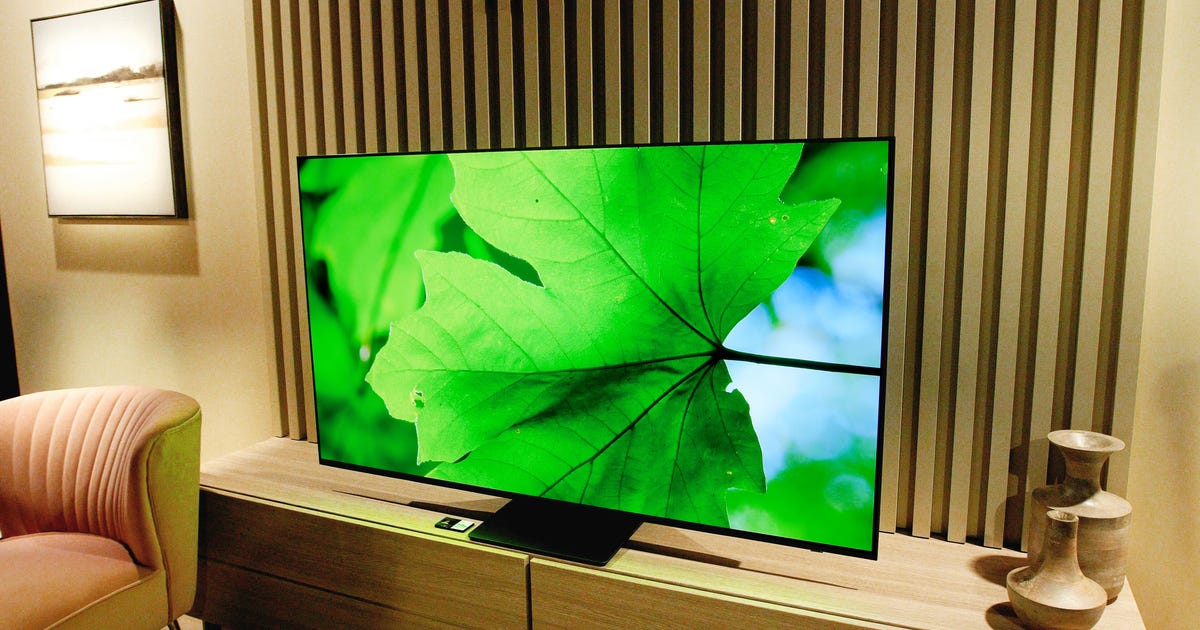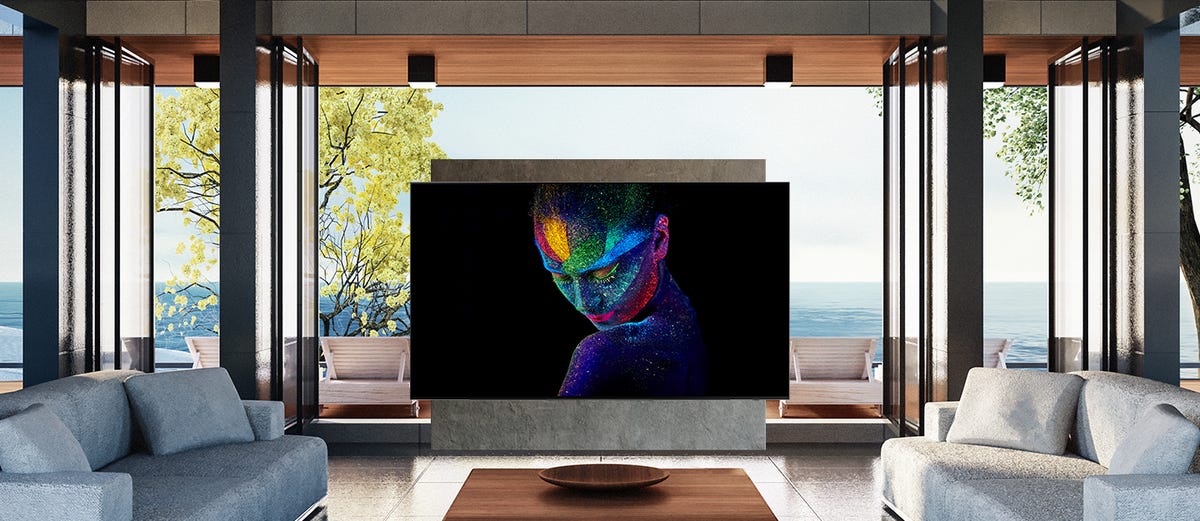Samsung oled tv first look why it will probably beat it lyrics samsung oled tv first invented samsung oled tv first came samsung oled tv first kill samsung oled tv first pictures samsung oled tv best buy samsung oled tv

Samsung OLED TV First Look: Why It Will Probably Beat Samsung's Own QLED TVs
It took a while but Samsung's OLED TV is official, and at a press preview in New York I finally got to see it in person. The Korean electronics giant, which has been No. 1 in TV market share worldwide for more than a decade, finally announced the elusive television earlier in March with a name, price and release date.
The S95B series will come in a 55-inch size for $2,200 and a 65-inch size for $3,000, and it is available for preorder now to ship later in April. OLED TVs currently deliver the best picture quality available, and Samsung's OLED TV could be its best yet -- and will likely outperform the company's own QLED models.
Unlike Sony's QD-OLED press preview, which featured engineers, a reference monitor and a standard OLED TV for side-by-side comparisons, Samsung's presentation of the S95B was pure "lifestyle." I encountered the television in a faux living room environment at Samsung's New York City showroom, the screen showing pretty demo footage with no other TV nearby. Unfortunately I can't really say anything substantial about the picture quality. I mean sure, it looked really good with punchy colors and a nice bright image, and from off-angle it didn't get substantially worse (as every LCD-based TV does, including QLED models). But Samsung's demo didn't reveal much more, and so I'll have to wait for a real review sample in CNET's lab to see how it stands up to the competition.
I can talk about what I expect, however. The S95B uses an all-new QD-OLED panel, which promises improved color, brightness and viewing angles compared with standard OLED TVs. The new panel technology could mean a new king of TV picture quality, but as always in the TV world, competition is stiff. First off, Sony's own QD-OLED TV, the A95K, looks pretty impressive. Then there's LG, which has been selling OLED TVs for the last few years and has new models of its own, using standard OLED panels and promising better brightness than ever.
I haven't reviewed any of these TVs yet but from what I've seen so far from Sony and LG, Samsung's S95B has its work cut out for it. Current OLED TV image quality is already so good that it might be difficult to convince high-end buyers to pay extra for QD's special sauce. LG has priced its new C2 models -- which are also available in a much wider variety of sizes than QD-OLED TVs, starting at 42 and going up to 83 inches -- hundreds of dollars less than the Samsung OLED TV, while LG's step-up 55- and 65-inch G2 OLED TVs, which promise better brightness, match Samsung's pricing.
Samsung also makes a dizzying variety of non-OLED TVs under its QLED brand, and they're very different from OLED. If past experience is any indication, Samsung's QD-OLED TV will deliver better overall picture quality than any of its QLED models. Yes, QLED TVs like the QN90A can get brighter than OLED, but in other areas that matter, such as contrast, color, uniformity and viewing angle, OLED TVs have always outperformed QLED TVs, which are based on LED and Mini-LED backlight technology.
OLED and QD-OLED are different because they don't use an LED backlight to produce light. Instead, light is produced by millions of individual OLED subpixels. The pixels themselves -- tiny dots that compose the image -- emit light, which is why it's called an "emissive" display technology. That difference leads to all kinds of picture quality effects, some of which favor LCD (and QLED), but most of which favor OLED.

In this photo provided by Samsung, the S95B looks a bit bigger than 65 inches, its true largest size.
SamsungAnd then there's the question of naming. In announcing the QD-OLED tech at CES, sister company Samsung Display called it a "QD Display," but the official name is simpler. "Since the term OLED is already widely accepted and understood, Samsung decided to go with the nomenclature 'Samsung OLED TV' to avoid confusion among consumers," a Samsung representative said.
It will be fascinating to see how TV shoppers respond to all the new choices, and I'm looking forward to checking out the new TVs soon.
Source
Blog Archive
-
▼
2023
(214)
-
▼
February
(38)
- GoPro Hero 9 Black Hands-on: All The Tools To Tell...
- Facebook's 3D Social Metaverse Will Be Partly Buil...
- 4 Ways Exercise Can Make You Happier -- Even If Yo...
- Google Pixel 3 XL Leak Shows USB-C Headphones And ...
- Apple Announces New $499 IPad Air And $399 IPad Mi...
- Make The Switch To PC Gaming With Up To 24% Off La...
- Nvidia Fined Over Cryptomining Disclosures. This W...
- Pixel 6A Deal Drops Google's Newest Phone Down To ...
- Pokemon Scarlet And Violet Teasing Another New Pok...
- Amazon Uses Snapchat To Send Exclusive Deals
- MediaTek's New Chipsets Pack In Features For High-...
- How To Stop WhatsApp From Sharing Your Data With F...
- Save Hundreds On Select Models Of Refurb IPads And...
- Does It Make Sense For You To Refinance Your Mortg...
- Moderna Asks FDA To Authorize COVID Vaccine For Ki...
- GoPro And PGA Tour Pair Up To Transform How The Wo...
- Samsung OLED TV First Look: Why It Will Probably B...
- Huawei Knocks Off Apple To Become No. 2 Phone Seller
- Home Price Increases Cooled Slightly In April
- Asus ZenBooks And Vivobooks Go 11th Gen All The Way
- The Smart #1 Is An Adorable New Electric SUV That ...
- Motorola One 5G Costs $445 And Will Have You Sayin...
- Facial Recognition System Mistakes Bus Ad For Jayw...
- DIY Holograms: Make Ghostly Images With Steam And ...
- Asus ZenBook 3 Review: A Windows Cure For Your 12-...
- Blast Zombies With A DIY Flamethrower Fueled By Co...
- Microsoft Spring Sale: Big Discounts On Laptops, K...
- The 15 Best RPGs On Nintendo Switch
- With Its New QD-OLED TV, Samsung May Soon Overtake...
- Millions Can't Pay Their Car Loans. Here's What To...
- 2021 Honda Civic Type R Limited Edition Will Be So...
- NASA Says Helicopters Flying On Mars Might Glow At...
- Lenovo Announced Its Thinnest Ever ThinkPad 2-in-1...
- Lenovo IdeaPad 730S Review: Thinner, Lighter MacBo...
- Oscars 2022: All The Winners On The Night
- Lenovo Announced Its Thinnest Ever ThinkPad 2-in-1...
- Best Ice Cream To Order Online
- Fake Coronavirus Tracking Apps Are Really Malware ...
-
▼
February
(38)
Total Pageviews
Search This Blog
Popular Posts
-
Speech pathologist job openings, birth to 3 speech pathologist job state of kansas, speech pathologist job new zealand, traveling speech pat...
-
Kerastase oleo relax treatment for hair, kerastase oleo relax serum, kerastase oleo relax masque, kerastase oleo relax hair products, kerast...
-
Br1m 21 years tobymac, br1m 21 years lyrics, br1m 21 years olds, br1m 21 years toby, br1m 21 years ago, br1m 21 years anniversary, br1m 21 y...
